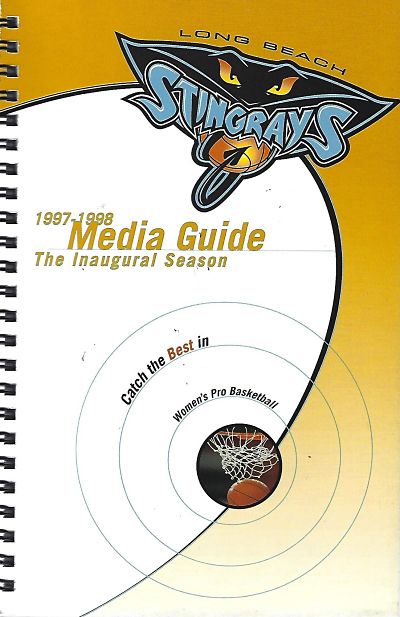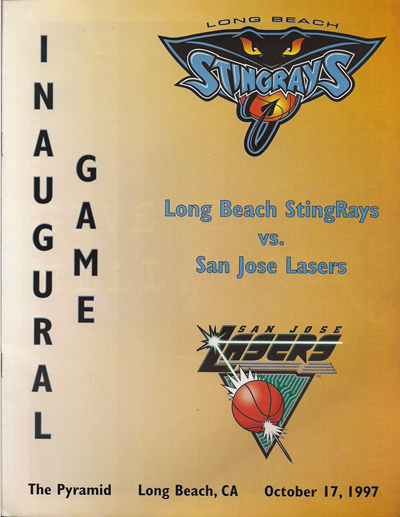American Basketball League (1997-1998)
Tombstone
Born: April 15, 1997 – ABL expansion franchise11997-98 American Basketball League Media Guide
Folded: August 26, 19982Gustkey, Earl. “Stingrays Close Shop After a Year”. The Times (Los Angeles, CA). August 27, 1998
First Game: October 17, 1997 (W 98-91 vs. San Jose Lasers)
Last Game: March 15, 1998 (L 86-81 @ Columbus Quest)
ABL Championships: None
Arenas
Long Beach Pyramid (4,000)31997-98 Long Beach Stingrays Media Guide
Branding
Team Colors: Black, Pantone Yellow, Orange (PMS 165) & Blue (PMS 291)41997-98 American Basketball League Media Guide
Ownership
Owner: American Basketball League
Attendance
The Stingrays ranked last in the ABL attendance table during their only season of existence.
Tilting your mobile device may offer better viewing.
Source: 1998-99 San Jose Lasers Media Guide
Background
To the extent that “minor league” sports work in this country – defining minor league in economic terms, rather than as a measure of player skill – the secret sauce is subsidy. Minor league baseball and hockey thrive thanks in part to annual payouts from Major League Baseball and the National Hockey League parent clubs. The Atlantic League of Professional Baseball has bucked the mostly dismal economic trends of independent (unaffiliated) baseball…thanks in large part to the gleaming taxpayer-funded ballparks erected in each of its eight cities.
In anticipation of a Gold Medal performance by the American women at the 1996 Atlanta Summer Olympics, two organizations launched plans for a national women’s professional basketball league in the United States. The best organized was the NBA-funded Women’s National Basketball Association (WNBA), set to debut in the summer of 1997. The NBA’s rival was the independent, single-entity American Basketball League (ABL). The ABL had two initial advantages over the WNBA. One, it got out of the gates first with a fall 1996 launch. Two, it lured the majority of the U.S. Olympic stars (eight players) with generous salaries and benefits. ABL salaries averaged $70,000 per player in 1997 with a range of $40,000 to $125,000. The WNBA chose to invest its money in marketing, offering a 1997 minimum salary of $10,000 with most top players earning $50,000 – or slightly above the ABL minimum.
“Most of our belief in the league comes from the players,” ABL co-founder Anne Cribbs told The Long Beach Press Telegram in October 1997. “We feel if we just get someone in once, they’ll fall in love with the league.”
Expansion Entry
By the fall of 1997, both leagues had one season under their belts. The WNBA succeeded far beyond its expectations, drawing a league average of 9,633 fans per game. More than 50 million fans watched the league on television contracts made possible by the NBA’s influence and relationships, including a network TV deal with NBC. Meanwhile, the ABL’s collection of high-priced talent toiled in relative obscurity, playing to average crowds of 3,500 per game and on second tier cable networks like Fox Sports Net and Black Entertainment Television.
Nevertheless, the ABL was still sufficiently optimistic to add an expansion franchise for their second season in the fall/winter of 1997-98. The Long Beach Stingrays would be the ABL’s foothold in the key Southern California market, one already occupied by the WNBA’s Los Angeles Sparks. It was the only market in the country where the ABL chose to go head-to-head with a WNBA franchise. In contrast to the Sparks – owned by the Buss Family, run by the Lakers and set to move into the state-of-the-art Staples Center in 1999 – the Stingrays were a decidedly low key affair. The team would play its home games at the 5,000-seat Pyramid on the campus of Cal State Long Beach.
Key players for the Stingrays included the 1996 U.S. Olympian and Gold Medalist Venus Lacy and former Florida Atlantic University center Yolanda Griffith, playing her first season in the U.S. after three years in Germany. 30-year old Clarissa Davis-Wrightsil was a former Wade Trophy Award winner (1989) as the nation’s best Division I women’s player and played on the 1992 U.S. Olympic team in Barcelona.
Debut
The Stingrays debuted at home on October 17th, 1997 and defeated the San Jose Lasers 98-91. Los Angeles Times columnist Bill Plaschke credited the ABL with assembling a clearly superior on-court product, noting that the Los Angeles Sparks failed surpass 93 points during their entire debut season. But Plaschke also pointed to the WNBA’s marketing superiority. He noted that the Stingrays failed to sell out their tiny arena with a crowd of just 3,108 for their inaugural game. The Sparks smallest crowd of the summer at The Forum was 5,987.
“The play was incredible,” an opening night fan named Anita Fitzgerald told Plaschke. “They had much better players than the Sparks. But compared to the Sparks, <the atmosphere> felt like a high school game.”
One Game Short
The Stingrays were strong throughout the season, finishing second in the Western Conference with a 26-18 record. Yolanda Griffith, in particular, was a dominant force. The 27-year old took home ABL Defensive Player-of-the-Year honors and finishing 2nd in MVP balloting. In the playoffs, the expansion Stingrays dispatched the Colorado Xplosion and the Portland Power en route to an ABL Championship Series showdown with the defending champion Columbus Quest. The Stingrays took the first two games of the best-of-five series in California, but dropped games 3, 4 and 5 on the road in Ohio to lose the series.
Contraction & Epilogue
By the end of the ABL’s second season, the league’s cash crunch became acute. Broadcast and sponsorship revenues stood far short of projections. As the offseason proceeded, the single-entity league took a scalpel to league expenses, shuttering the weakly-supported Atlanta Glory franchise in March 1998 and imposing a 10% across-the-board paycut on league staff. On August 26th, 1998 the ABL closed down the Stingrays franchise after a single season of play. ABL chief executive Gary Cavalli cited the Stingrays poor sales results, noting that the club had sold less than 300 season tickets with the season only two months away.
“The major bloodletting is over,” Cavalli told The Los Angeles Times. “I’m tired, this is enough pain.”
It wasn’t. The ABL’s third season got under way in November 1998, but played only a month-and-a-half before folding in midseason on December 22, 1998. The league filed for bankruptcy on New Year’s Eve 1998 with debts of $10 million.
Yolanda Griffith went on to become an 8-time WNBA All-Star and won the league’s 1999 MVP award. She played her last pro game in 2009.
Clarissa Davis-Wrightsil was inducted into the Women’s Basketball Hall of Fame in 2006.
Long Beach Stingrays Shop
[auction-nudge tool=”listings”]
Long Beach Stingrays Video
1998 ABL Championship Series, Game 5. Stingrays at Columbus Quest. May 15, 1998.
Downloads
Meet The Stingrays: 1997-98 Numerical Roster & Bios
1997-98 Long Beach Stingrays Numerical Roster & Bios
10-21-1997 Stingrays vs. Colorado Xplosion Game Notes
Links
###




2 Responses
… and the Seattle Reign, one of the best-named sports teams ever. ;-(
It WAS fun while it lasted . . .
The ABL was a superior product and the basketball was entertaining. But there was always a sense that the league was founded more on good intentions than on any sports business sense, and that this was David going up against the Goliath of the NBA-backed WNBA.
The Stingrays were fun to watch, and built a true rivalry with the Natalie Williams-led Portland Power. Portland won the division title by one game, but the Stingrays knocked them out of the playoffs.
The franchise’s highlight came in the finals against the defending champion Columbus Quest, easily the league’s most dominant team in the regular season. The Stingrays stunningly won the first two games in Long Beach, but then got swept in the final three games in Columbus, in what turned out to be the franchise’s final games.
But the real revelation of watching the Stingrays was the play of Yolanda Griffith, a Chicago native who was just back from years of playing in Germany. This was a more svelte Griffith than her later days in Sacramento, and she ran the floor like a small forward, devastating on defense and a force on offense.
It all ended far too soon, but for their relatively few fans in that one season, it was a lot of fun.